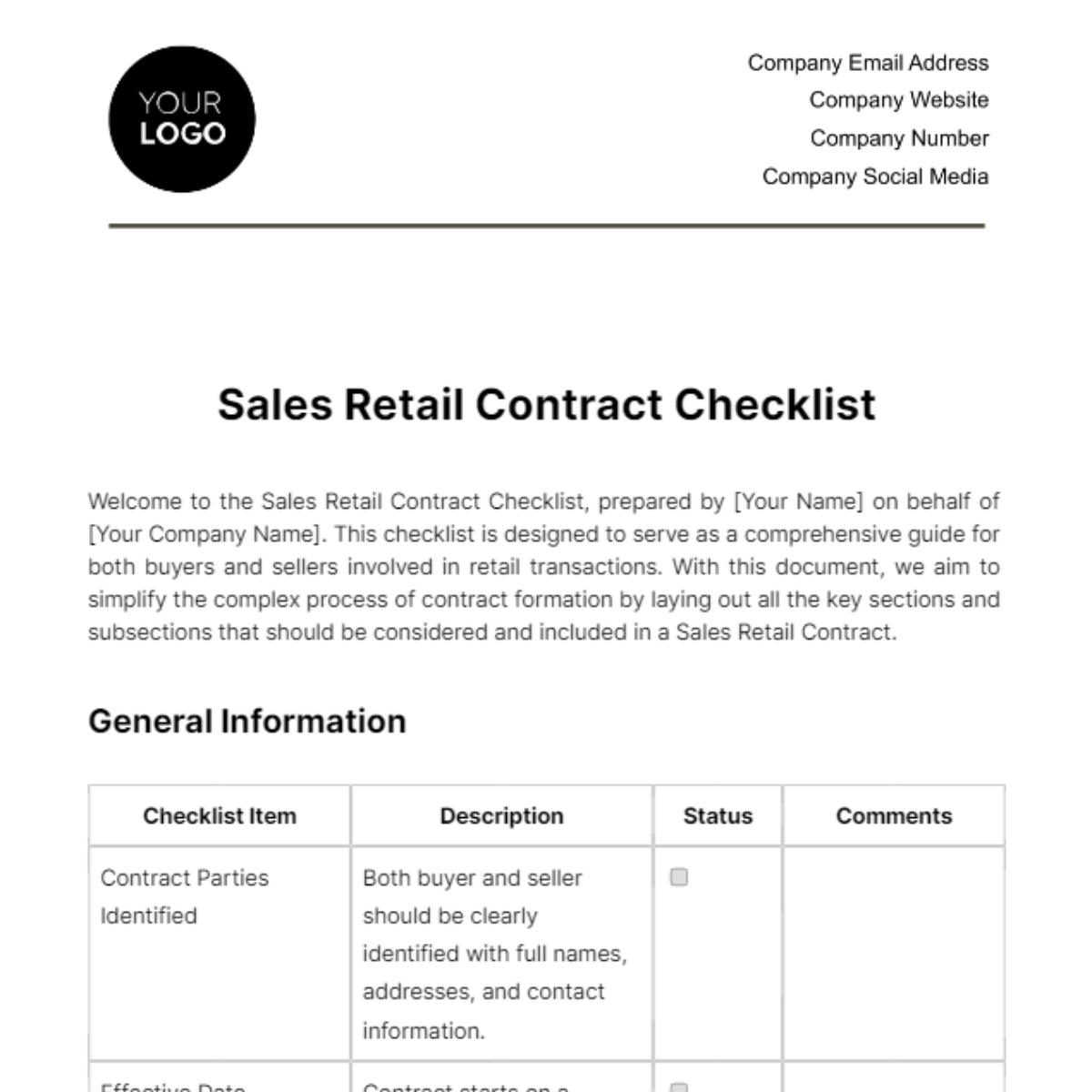Sales Study on Contracts and Business Growth
I. Executive Summary
This Sales Study aims to explore the nuanced relationship between contracts and business growth for [Your Company Name]. By investigating the types of contracts, their impact, and best practices, this study serves as a roadmap for business expansion and risk mitigation. Contracts are more than just formal agreements; they are strategic tools that can significantly influence your business trajectory. This comprehensive study delves into various types of contracts, from fixed-price to time and materials, and how each can be optimized for your specific business needs. Beyond types, the study examines the far-reaching impact of these contracts, not just on immediate transactions but also on long-term business relationships and growth prospects.
Additionally, the study presents tried-and-true best practices in contract management, aiming to guide your team in leveraging contracts as assets rather than viewing them as mere necessities or, worse, liabilities. By combining empirical data, case studies, and expert opinions, this document provides actionable insights that can serve as a roadmap for enhancing your contract management procedures. Ultimately, the objective is to equip [Your Company Name] with the knowledge and strategies needed for intelligent contract drafting, negotiation, and execution, all with the end goal of catalyzing sustainable business expansion and mitigating associated risks.
II. Objective and Scope
Objective
The primary objective of this Sales Study is to offer a robust and comprehensive analysis of the role that contracts play in either facilitating or hindering business growth. Recognizing that contracts serve as the backbone of any commercial relationship, the study aims to shed light on best practices, common pitfalls, and the overall impact of contract management on business expansion.
Scope
The scope of this study is extensive and covers a range of critical areas necessary for a holistic understanding of the subject:
Importance of Contracts: This section delves into the intrinsic value of contracts as legal and strategic tools, highlighting how they establish the rules of engagement between parties and protect both rights and interests.
Types of Contracts: This part provides an overview of various types of contracts—such as fixed-price, cost-plus, and time & materials—and how each type can be best applied to different business scenarios.
Impact on Business Growth: Here, the study investigates the direct and indirect ways in which contracts can influence a business's growth trajectory. This includes not only immediate financial gains but also intangibles like brand reputation and customer relationships.
Strategies: Drawing from industry benchmarks and case studies, this segment outlines strategic approaches to contract management that can be employed to facilitate growth, including negotiation tactics, compliance monitoring, and renewal strategies.
Pitfalls to Avoid: This section offers a cautionary tale, identifying common mistakes and pitfalls in contract management that can hamper growth or expose the business to unnecessary risks.
By covering these key areas, the Sales Study aims to provide [Your Company Name] with a comprehensive guide for leveraging contracts as a strategic asset for sustained business growth.
III. Importance of Contracts
Contracts are indeed the cornerstone of any business relationship, serving not just as a legal safety net but also as a blueprint for how each party expects the relationship to be managed. They articulate the expectations, terms, roles, and responsibilities that all involved parties are obligated to adhere to. A well-drafted contract provides a robust framework for various aspects of the business interaction, from payment terms and quality standards to timelines and dispute resolution mechanisms.
Moreover, contracts lend a degree of predictability and stability to what might otherwise be a volatile and uncertain business landscape. For instance, they lock in prices and service levels, thereby helping to budget and plan more effectively.
Additionally, they serve as a record of agreements reached, which can be invaluable in the event of misunderstandings or disputes. In the context of business growth, contracts also offer the opportunity to cement long-term relationships with key clients or vendors, serving as a foundation upon which trust and expanded business can be built.
In essence, contracts are not merely legal necessities but strategic instruments that can help define the trajectory of a company’s growth and sustainability. By understanding the true importance of contracts, a business can better position itself to exploit opportunities and mitigate risks.
IV. Types of Contracts
Understanding the different types of contracts is crucial for determining which is most suited for a particular project or business relationship. The type of contract you choose can significantly impact the financial viability, project timeline, and general success of an endeavor. Here, we break down the most commonly used types of contracts in business, highlighting their features, and suggesting appropriate use-cases.
Type of Contract | Description | Suitable For |
|---|---|---|
Fixed-Price | Involves a predetermined total cost for the project. The price doesn't change unless the scope of work changes. | Short-term, well-defined projects where the scope and costs are clearly understood. |
Time & Materials | Cost is based on the time and resources used. The cost fluctuates depending on the actual work done and materials used. | Ongoing or long-term projects where the scope isn't clear, making it difficult to estimate costs upfront. |
Retainer | Involves regular payments, typically monthly, for ongoing services. The scope may or may not be fixed. | Long-term relationships or services where there's a need for ongoing work over a period of time. |
Choosing the right type of contract is essential for balancing risk and reward, and each type has its own set of advantages and disadvantages. For example, Fixed-Price contracts are straightforward but can be risky if the project scope is not well-understood. Time & Materials contracts offer more flexibility but require rigorous management to keep costs in check. Retainer contracts are excellent for ongoing relationships but necessitate clear communication to ensure both parties are aligned on expectations.
V. Impact on Business Growth
The role of contracts in business growth cannot be overstated. When executed well, they act as catalysts that propel a business forward by ensuring clear terms, reliable partnerships, and a framework for performance. They can set the foundation for strong, sustainable relationships with vendors, partners, and customers, providing the stability required for long-term growth.
However, contracts can also be a bottleneck for growth if not managed efficiently. Poorly crafted contracts can lead to misunderstandings, legal disputes, and tarnished relationships, ultimately hampering growth. For instance, a contract that is too rigid can hinder adaptability, making it difficult to respond to market changes and opportunities. On the other hand, contracts that are too ambiguous can lead to disputes that are costly both in terms of time and resources.
A bad contract can also have a cascading effect on other aspects of a business. For example, if a supplier contract falls through due to poor contract management, it can lead to delays in product development or launching, which can, in turn, affect sales, market share, and growth projections. Additionally, contractual issues can affect company reputation, making it harder to secure new contracts and partnerships in the future.
Conversely, well-crafted contracts can enhance business growth by clearly defining expectations, reducing uncertainties, and laying the groundwork for smooth operational execution. They can also serve as tools for strategic planning, helping businesses align their objectives with market demands.
In summary, the impact of contracts on business growth is a double-edged sword. Their influence can be either highly beneficial or detrimental, which is why it's critical to invest the necessary time and resources into crafting and managing them effectively.
VI. Strategies for Maximizing Impact
The strategic management of contracts can significantly influence a company's trajectory, making the difference between stagnation and sustainable growth. This section delves into three core strategies that are instrumental for leveraging
contracts to their full potential: Streamlined Contract Management, Flexibility and Scalability, and Risk Assessment. Each strategy is designed to enhance various aspects of contracting, from operational efficiency to adaptability and risk mitigation. The ultimate aim is to transform contracts from mere transactional documents into strategic assets that drive business growth and safeguard interests. Adopting these strategies can lead to a more streamlined, flexible, and risk-aware approach to contracting, thereby setting the stage for long-term success.
Streamlined Contract Management. One of the most effective ways to leverage contracts for business growth is through streamlined contract management. This involves the use of standardized templates, automated workflows, and digital storage solutions. By systemizing the process, companies can accelerate the contract lifecycle, thereby saving time and resources. Streamlined management ensures that contracts are easily accessible, searchable, and manageable, thereby reducing the likelihood of errors or oversights that could result in legal disputes or lost opportunities.
Flexibility and Scalability. A contract should not be a straitjacket that stifles a business's ability to adapt to market changes. Flexibility in contractual terms can be a critical factor for long-term business growth. This includes provisions for renegotiating terms, adjusting timelines, and scalability clauses that allow for the expansion of services or goods provided. These flexible terms can make it easier to adapt to market conditions, new opportunities, or unforeseen challenges, thus facilitating smoother operations and continued growth.
Risk Assessment. Understanding and assessing the risks associated with each contract is essential for maximizing its positive impact on business growth. This includes financial risks like payment terms and credit exposure, as well as operational risks such as supply chain disruptions or the quality of goods and services provided. Conducting a comprehensive risk assessment prior to finalizing a contract can help in identifying potential pitfalls and incorporating clauses that protect the business. A well-executed risk assessment can inform more strategic negotiations, help avoid damaging legal disputes, and lead to more robust, beneficial contracts.
By implementing these strategies, a business can optimize the impact of contracts on its growth trajectory. The key is to approach contracting as a strategic function rather than a mere administrative task. In doing so, companies can turn contracts into powerful tools for advancement, risk mitigation, and relationship building.
VII. Pitfalls to Avoid
Navigating the complexities of contract management involves more than just understanding the best practices; it also requires an awareness of the common mistakes that can undermine the effectiveness of a contract and impede business growth. This chapter, "Pitfalls to Avoid," aims to shed light on some of the frequent missteps companies make in the contract lifecycle. From the intricacies of drafting to the subtleties of performance monitoring, these pitfalls can create challenges that range from legal disputes to operational inefficiencies. By identifying and understanding these potential hazards, businesses can adopt strategies to sidestep them, thereby solidifying the foundation for robust, growth-oriented contractual relationships.
Overcomplicating Contracts. While it's crucial to cover all bases when drafting a contract, overcomplicating the document with excessive legal jargon or convoluted clauses can lead to misunderstandings and disputes. Both parties must fully understand the terms and conditions they are agreeing to. Overcomplicated contracts can also slow down the negotiation process and make it more difficult to adapt the agreement to changing circumstances. Therefore, clarity and simplicity should be the guiding principles when drafting contracts.
Ignoring Local Regulations. Businesses often make the mistake of drafting contracts without adequately considering local or industry-specific regulations, which can result in non-compliance and potential legal repercussions. This is particularly critical for companies operating in multiple jurisdictions or in highly regulated industries. Non-compliance can result in fines, legal action, and damage to reputation, all of which can significantly impact business growth. To avoid this pitfall, businesses should consult legal experts familiar with the pertinent local and industry regulations when drafting contracts.
Poor Monitoring. Once a contract is signed, the work isn’t over. Poor monitoring of contract performance can lead to missed deadlines, unfulfilled obligations, and dissatisfaction among parties. This can result in a loss of trust and potential legal disputes that are costly both in terms of time and resources. Effective contract management software can automate monitoring, sending reminders for important dates and flagging any deviations from the agreed-upon terms. Companies should also regularly review contract performance against expectations to ensure all parties are fulfilling their obligations and to identify areas for improvement.
By being aware of these common pitfalls and taking proactive steps to avoid them, businesses can create contracts that are not only legally sound but also conducive to long-term growth and strong partnerships.
VIII. Case Studies
The following case studies provide real-world examples of how contracts can have a direct impact—both positive and negative—on business growth. These scenarios offer valuable insights into best practices and pitfalls in contract management and structure.
Case Study 1: [Company X] Experienced Exponential Growth by Optimizing Their Contract Management System |
|---|
[Company X] implemented a contract management system that automated several key functions like tracking, reporting, and renewals. This allowed them to focus on strategic decision-making and customer engagement rather than administrative work. By streamlining their contract management, they reduced errors and delays in the contract life cycle, improving efficiency and customer satisfaction. The company also benefited from data analytics, which provided insights into contract performance, buyer behavior, and market trends. This data-driven approach enabled them to make more informed decisions and tailor their services to meet customer needs more precisely. As a result, [Company X] experienced exponential growth within two years of implementing the optimized system. |
Case Study 2: [Company Y] Faced Stagnation Due to Inflexible Contract Terms |
|---|
In contrast, [Company Y] had long-term, fixed-price contracts that lacked clauses allowing for adjustments based on market conditions or performance metrics. This inflexibility made it difficult for the company to adapt to changing market dynamics or innovate their product offerings. Customers became frustrated with the lack of adaptability and began seeking more flexible options from competitors. Consequently, [Company Y] faced revenue stagnation and even lost some of its market share. The rigid structure of their contracts impeded the company's ability to evolve and grow, highlighting the importance of building flexibility into contract terms. |
By examining these case studies, businesses can glean crucial lessons on the do's and don'ts of contract management and its impact on business growth.
IX. Recommendations
In light of the findings from this Sales Study on Contracts and Business Growth, we offer the following targeted recommendations:
Adopt a Flexible Yet Robust Contract Management System: Implement a contract management system that combines automation with flexibility. This should include features like automated tracking, reporting, and renewal processes, but also be easily adaptable to unique contractual requirements or market conditions.
Incorporate Scalable Terms: Always include scalability clauses in your contracts to accommodate both upward and downward shifts in demand, market conditions, or technological changes. This allows your business to adapt without requiring a complete contract overhaul.
Regular Risk Assessments: Conduct periodic risk assessments to evaluate the potential hazards associated with existing contracts. Utilize these assessments to update or renegotiate terms as needed, thereby minimizing vulnerabilities.
Local Regulation Compliance: Make sure to stay abreast of local laws and regulations affecting your contracts. Ignorance is not a defense in legal matters, and non-compliance can not only result in financial penalties but can also harm your business reputation.
Monitoring and Data Analysis: Use analytics tools to continuously monitor contract performance. This data can be instrumental in making informed business decisions and identifying areas for improvement or renegotiation.
Training and Skill Development: Invest in training programs for team members involved in contract drafting, negotiation, and management. Well-informed staff are less likely to make costly errors and are better equipped to negotiate favorable terms.
Customer Feedback Loops: Establish a system for collecting and analyzing customer feedback related to contract terms and service delivery. This will not only improve customer relations but also provide valuable insights for future contract negotiations.
By implementing these recommendations, [Your Company Name] can create a more agile, responsive, and effective contract management system that facilitates rather than hinders business growth.
X. Conclusion
The role that contracts play in business cannot be overstated. They form the legal and operational foundation upon which commercial relationships are built. However, contracts are not merely transactional documents; they can either spur or inhibit business growth depending on their quality, adaptability, and how well they are managed. This Sales Study has provided a comprehensive overview of the multifaceted relationship between contracts and business growth, and serves as a critical resource for [Your Company Name].
We've explored the importance of different types of contracts, their potential impact on business growth, and strategies for maximizing that impact. Moreover, we've outlined common pitfalls to avoid and illustrated these points through real-life case studies. Our goal has been to offer a roadmap for how to approach contract management as a strategic business function, rather than an administrative necessity. The recommendations section provides a synthesized list of actionable steps to harness the full power of contracts as tools for growth.
By adopting the suggested methodologies and avoiding identified pitfalls, [Your Company Name] can not only safeguard its current operational efficiency but also lay a robust groundwork for future expansion and profitability. Therefore, the integration of a strategic approach to contract management is not just advisable but imperative for long-term, sustainable business growth.

















































